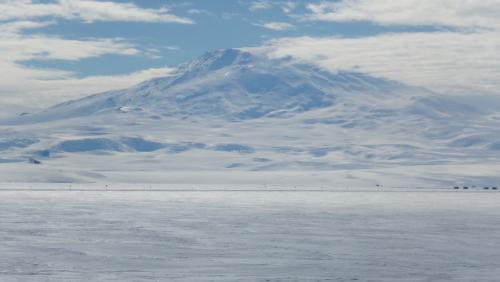Today I got to spend part of the day in the McMurdo Ice Sheet. This was really my first time in the field, most of my responsibilities have been on Station so far so this was a real treat.
 This is near the transition zone. There were better pictures showing pressure ridges but none of those showed off my beard.
This is near the transition zone. There were better pictures showing pressure ridges but none of those showed off my beard.
My visit was courtesy of Dr. Doug MacAyeal. Doug is a glaciologist who has been studying the ice for 40 years. He is currently investigating the way in which the ice cracks. This is not well studied in Antartica but is very important because it goes directly into the stability of the sheet. Perhaps you have read recently about the British Halley station that was recently evacuated because of a worrying crack in the ice. The Halley base is on the other side of Antartica from where I am (interestingly, the base is on skis, so as long as it is still there, they may be able to move it later). That is only one example, if you want to get anything done in Antartica or similar places in the world you often depend on the stability of the ice sheet. Here at McMurdo the airfield, Williams Field, sits on the McMurdo Ice Sheet. If that sheet fails McMurdo would need to be maintained entirely by ship. That would make things difficult indeed. Doug is investigating the many ways that ice can crack.
 Phil and Doug documenting the process by the flat-track.
Phil and Doug documenting the process by the flat-track.
There is some evidence that the warmer temperatures in summer can lead to cracking, but that has only been studied in northern hemisphere glaciers, which are in a different environment in many ways. The McMurdo Ice Sheet often develops cracks from sea swells pushing up on the ice. But there are other factors that play a role. So that is why Doug started working with IRIS (Incorporated Research Institutions for Seismology) and their PASSCAL (Portable Array Seismic Studies of the Continental Lithosphere) program (scientists love acronyms!). PASSCAL is a program that loans seismic equipment to researchers. More importantly, they can support researchers with their expertise in the equipment. That is where Phil came in. Phil Chung is a IRIS PASSCAL engineer and he helped Doug put in a couple of seismometers to measure vibrations in the ice that are produced when the ice cracks or swells.
 Phil Chung doing diagnostics on the seismometer.
Phil Chung doing diagnostics on the seismometer.
And these instruments are very sensitive. Doug has told me that they can actually detect waves caused by storms in Seattle (I have no idea how they parse that out of the data, but Doug has promised to send me an explanation). Anyway, we went out to retrieve one of the seismometers on the ice today. Like almost every endeavor in Antartica it involved digging something out of the snow. But it was a beautiful day and the seismometer wasn't buried very deep, so it was done before we knew it. And there was a great view of Mt. Erebus from there.
 Mt. Erebus from the McMurdo Ice Sheet.
Mt. Erebus from the McMurdo Ice Sheet.

Comments
Add new comment